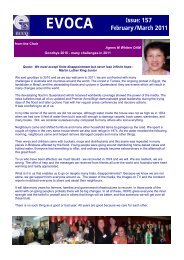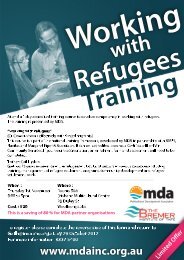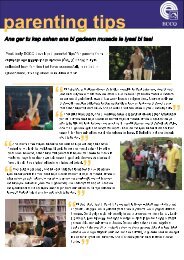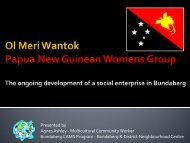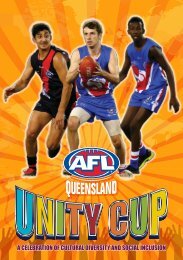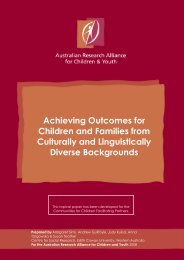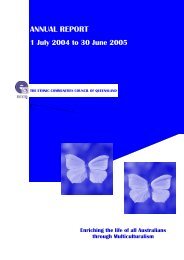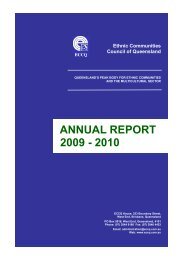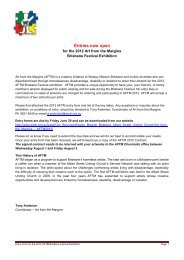Good Practice Guide
CALD Good practice guide
CALD Good practice guide
You also want an ePaper? Increase the reach of your titles
YUMPU automatically turns print PDFs into web optimized ePapers that Google loves.
GOOD PRACTICE GUIDE<br />
3. WHO ARE MIGRANTS, REFUGEES AND ASYLUM SEEKERS?<br />
In NSW, where unattached minors<br />
live outside of detention centres, the<br />
Commonwealth government delegates<br />
responsibilities for guardianship to the<br />
Director-General of the Department of<br />
Community Services (DoCS). Where this<br />
occurs, DoCS often makes arrangements<br />
with care providers who share the child's<br />
religious or cultural backgrounds.<br />
If an unaccompanied refugee minor in the<br />
community is suspected to be at risk of<br />
harm, regardless of their refugee status,<br />
DoCS must respond in the same way<br />
as for any child or young person.<br />
3.5 Asylum seekers<br />
When people come to Australia seeking<br />
refugee asylum on-shore, they are<br />
identified as 'asylum seekers' until their<br />
claims for refugee status are validated or<br />
disproved. In the past, once an asylum<br />
seeker's refugee status was validated they<br />
were granted Permanent Protection Visas<br />
(PPV). PPV holders were allowed<br />
permanent residency status. This granted<br />
the same entitlements as available to<br />
refugees who had entered Australia under<br />
the Refugee Program.<br />
Recent legislative changes introduced<br />
Temporary Protection Visas (TPVs).<br />
Currently all on-shore asylum seekers<br />
who have a valid claim for refugee status<br />
are granted a TPV for a three year period.<br />
During this time they are not able to<br />
bring their families to Australia and<br />
their visa ceases if they leave Australia.<br />
After 30 months TPV holders can apply<br />
for a further protection visa 7 , but they<br />
are eligible for a strictly limited range of<br />
settlement assistance/services that are<br />
routinely provided to permanent residents 8 .<br />
All refugees have at one time been<br />
asylum seekers until their status as<br />
'refugees' has been assessed and<br />
validated. Often asylum seekers are<br />
held at immigration detention centres<br />
while the process of determination is<br />
conducted. Asylum seekers whose claim<br />
to refugee status has failed - as well as<br />
people who arrive in Australia, stay<br />
unlawfully and do not apply for refugee<br />
status - may be held in detention until<br />
they are removed from Australia 9 .<br />
6<br />
7 Department of Immigration and Multicultural and Indigenous Affairs, 27 August 2004, Seeking Asylum Within Australia, (online), Commonwealth of Australia, Available from:<br />
http://www.dimia.gov.au/refugee/seeking_asylum.htm http: (Accessed 17 January 2005)<br />
8 Department of Immigration and Multicultural and Indigenous Affairs, 20 November 2003, Assistance for Asylum Seekers in Australia, (online), Commonwealth of Australia, Available from:<br />
http://www.immi.gov.au/facts/index.htm#humanitarian (Accessed 17 January 2005)<br />
9 Acting Federal Race Discrimination Commissioner (2001), Face the Facts, Some Questions and Answers About Immigration, Refugees and Indigenous Affairs, p7



